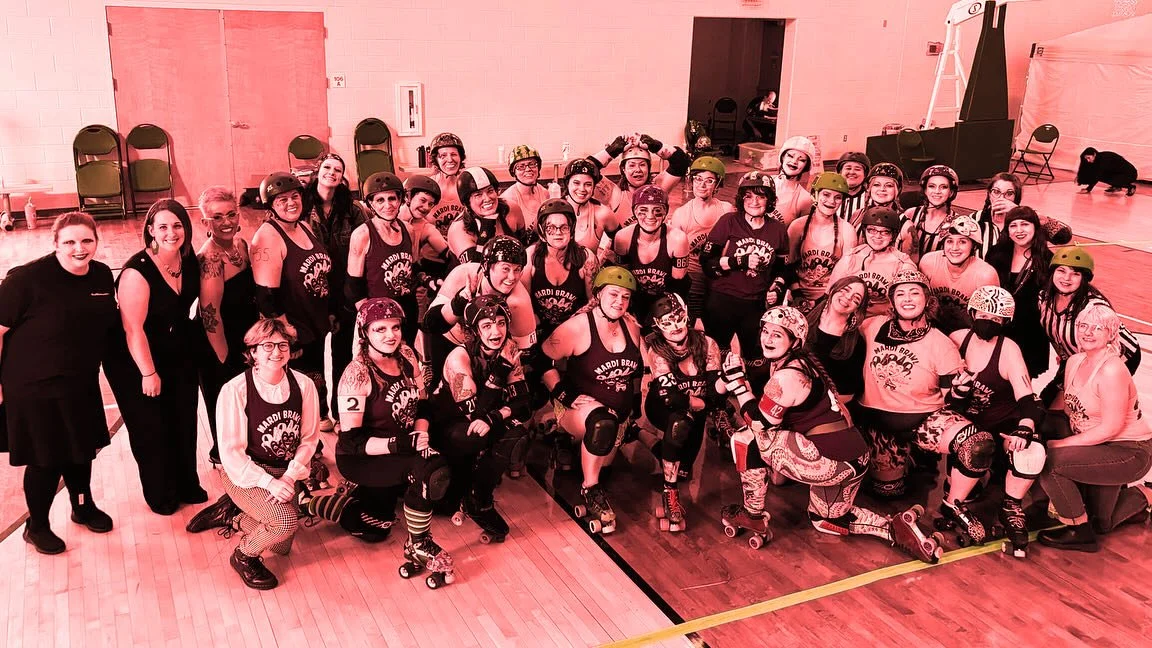HOW TO PLAY ROLLER DERBY
A FAST-PACED, FULL-CONTACT SPORT ON WHEELS
Photo: Antie Razzi
JAMMER
Jammers wear a star on their helmets and are the scoring players for each team. Jammers attempt to pass the opponents as many times as possible per jam by sprinting around the track and lapping the pack. The first jammer to legally pass the pack is declared Lead Jammer. The lead jammer may call off the jam at any time by placing hands on the hips twice in a row.
Photo: Antie Razzi
BLOCKERS
Blockers are simultaneously focused on stopping the opposing Jammer from passing them and assisting their Jammer to pass the opposing team’s Blockers. The pack is formed by the largest group of Blockers with players from each team on the track.
Photo: Antie Razzi
PIVOT
The Pivot is the Blocker that wears the stripe on their helmet cover. They are the only Blocker that is allowed to accept a star pass from the Jammer, thus becoming the new Jammer and gaining the ability to score points.
THE BASICS OF ROLLER DERBY
Flat track roller derby is a fast-paced, full-contact team sport that requires speed, strategy, and athleticism. Two 15-skater teams play two 30-minute periods. Each period consists of multiple “jams.” Each jam is an opportunity for both teams to score points, and ends after 2 minutes or when the Lead Jammer calls off the jam.
It is legal for a skater to block opponents with their hips, rear, and shoulders. It is not legal to block to the back, to trip, to elbow, or to back-talk officials. Players committing illegal actions are penalized 30 seconds and their team plays short for that time.
Click the video to learn more!
Team Photo: Eric Romero
OFFICIALS OF ROLLER DERBY
THE ZEBRAS AND ADDITIONAL CREW OF THIS FAST PACED SPORT
REFEREES
Referees otherwise known as Skating Officials are a huge part of Roller Derby. Referees wear skates, protective gear, and are easily identified by their black and white striped shirts. They are often nicknamed the Zebras of the sport due to their jerseys. Typically there are five to seven referees participating in each game, but roller derby can happen with as few as three referees; seven is considered a full crew.
NSOs
NSOs otherwise known as Non-Skating Officials do not wear skates nor protective gear, and they are not always easy to identify. NSOs can wear either a black shirt or a pink shirt; it should have the word “official” printed on the back. You’ll find them mixed in with all the referees. NSOs are the people who handle all of the paperwork, time everything, and keep track of penalties. They may also be allowed to call penalties specific to their position.
PENALTY BOX
Referees and NSOs help with penalties throughout the bout. When a skater commits a penalty; a ref will blow their whistle, call out the skater’s number and jersey color as well as the penalty performed and its associated hand signal. The penalized skater must immediately leave the track. Upon arriving at the penalty box, the skater must sit in the seat being pointed at. As soon as the skater sits, their penalty time begins. Skaters serve 30 seconds of Jam time for each penalty assessed to them. The final 10 seconds of their penalty time must be served while standing.
KEY OFFICIATING SIGNALS
Lead Jammer -
• Wears a star on their helmet
• The only skater that scores points
• The only Skater who may call off a Jam before the full two minutes elapse.
• They call off the Jam by repeatedly placing their hands on their hips.
Jammer Call Off -
The Lead Jammer calls off or ends the Jam by repeatedly placing their hands on their hips. They use this signal to indicate to the refs that they are calling off/ending the jam.
Track Cut -
It is illegal for a Skater to use the out-of-bounds area to gain position on someone who is upright and in bounds. This action is referred to as “cutting the track.” Skaters who are out of bounds must return in bounds behind any upright and in-bounds Skater who they were behind when they left the track.
Multiplayer Block -
Skaters may not form a wall by linking with or grasping a teammate, or otherwise forming an impenetrable connection. This action warrants a penalty if an opponent attempts to get between them and fails to do so due to the illegal formation.
Out of Play -
One arm or hand touching the floor beyond the track boundary does not render a Skater out of bounds. An out of play warning is from a blocker who is in bounds, but positioned outside of the Engagement Zone. If no Pack is defined, all blockers are out of play.
Forearm Penalty -
Forearms are not a legal blocking zone. If a skater uses their forearms to separate the blockers a penalty will be called.








